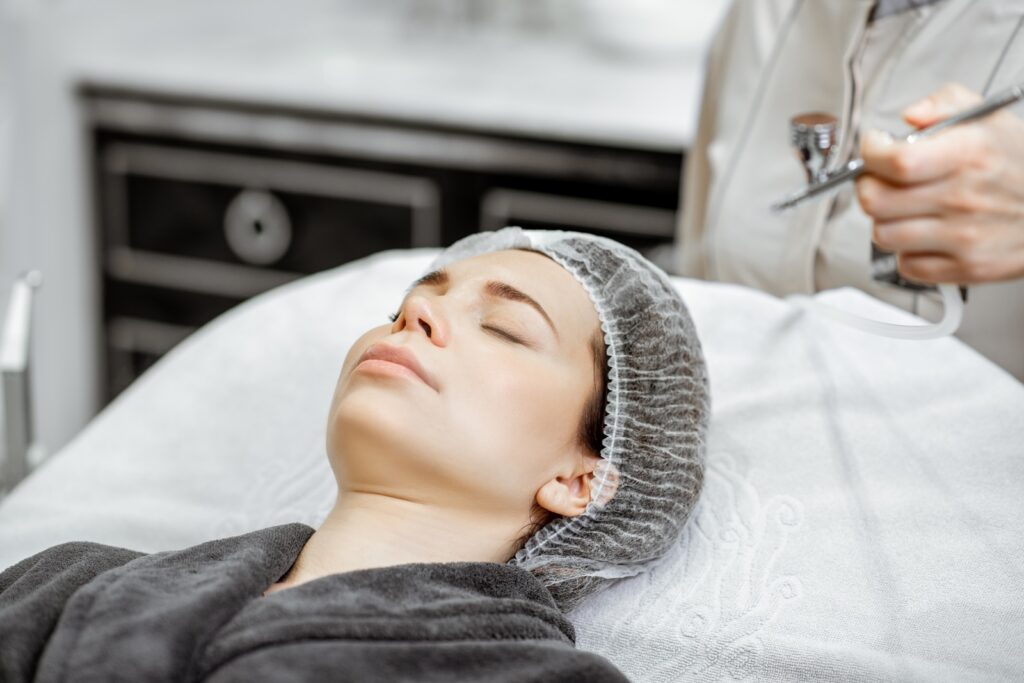Photofacial Treatment in Islamabad
A photofacial, also known as a photorejuvenation or IPL (Intense Pulsed Light) treatment, is a non-invasive cosmetic procedure used to improve the appearance of the skin by targeting various skin concerns and imperfections.
It utilizes high-intensity light pulses of varying wavelengths to treat issues such as sun damage, age spots, redness, and uneven skin tone.
The process typically begins with a consultation with a qualified dermatologist or skincare professional. During this consultation, the provider assesses the patient’s skin type, specific concerns, and goals to determine if a photofacial is the right treatment.
Procedure
The photofacial procedure involves several key steps to effectively treat various skin concerns and improve the skin’s appearance:
Protective Eyewear
Before the procedure begins, the patient is provided with protective eyewear. This eyewear is essential because the intense light generated during the treatment can be harmful to the eyes. The eyewear is designed to shield the patient’s eyes from the bright flashes of light produced by the IPL device, ensuring their safety during the procedure.

Cooling Gel Application
To protect the skin and enhance the patient’s comfort during the photofacial, a cooling gel is applied to the treatment area. The gel serves multiple purposes, including:
Acting as a protective barrier to prevent excessive heat or damage to the skin’s surface.
Enhancing the effectiveness of the treatment by allowing the IPL device to make better contact with the skin.
Reducing any potential discomfort or heat sensation from the intense light pulses.
Calibration of IPL Device
The IPL device used for the photofacial is calibrated to emit specific wavelengths of light that are tailored to the patient’s individual skin condition and concerns. This customization is crucial because different skin issues, such as pigmented spots, redness, or fine lines, may require different wavelengths for optimal treatment. The provider adjusts the settings on the IPL device to target the specific concerns and areas of the patient’s skin.
IPL Treatment
Once the IPL device is calibrated to the appropriate settings, the handheld device is applied directly to the patient’s skin. The device emits brief, intense pulses of light. These light pulses are selectively absorbed by the targeted skin cells and pigments, depending on the specific skin issues being addressed. For example, melanin in pigmented spots or blood vessels in cases of redness may absorb the light energy, leading to their breakdown or reduction in visibility.
The entire photofacial procedure is typically performed in a controlled and clinical setting by a qualified healthcare professional or a licensed practitioner. The treatment can be customized to address the patient’s unique skin concerns, and the level of discomfort is generally manageable. After the procedure, patients may experience some redness or swelling, but these side effects are temporary and tend to subside within a day or two. Multiple sessions are often recommended to achieve the best results, and patients are advised to follow post-treatment care instructions, including sun protection, to maintain the improvements in their skin’s appearance.

Targeted Concerns
Photofacials are a versatile cosmetic procedure designed to address a variety of common skin concerns and improve the overall appearance of the skin. Here’s an elaboration of the targeted concerns that photofacials can effectively address:
Sunspots and Age Spots
Photofacials are particularly effective at treating sunspots (also known as solar lentigines) and age spots (lentigines). These are pigmented spots on the skin that result from sun exposure and aging. The intense light energy emitted during the treatment is absorbed by the excess melanin in these spots, causing the melanin to break down. Over time, the spots gradually fade, leading to a more even skin tone.
- Rosacea and Redness: Rosacea is a skin condition characterized by redness, visible blood vessels, and sometimes, pimples. Photofacials can help reduce the redness associated with rosacea by targeting the blood vessels that contribute to the condition. The intense light pulses are absorbed by the blood vessels, leading to their collapse or shrinkage, which in turn reduces the overall redness and flushing associated with rosacea.
- Fine Lines and Wrinkles: Photofacials stimulate the production of collagen, a critical protein for maintaining skin’s firmness and elasticity. Increased collagen production can help improve skin texture and reduce the appearance of fine lines and wrinkles. This is especially valuable for those seeking non-invasive anti-aging treatments.
- Uneven Skin Tone and Texture: Photofacials are effective in addressing issues related to uneven skin tone and texture. The treatment can help fade pigmented areas and dark spots, resulting in a more balanced and even complexion. Additionally, it can help improve the overall texture of the skin, making it smoother and more youthful.
- Enlarged Pores: Photofacials can also be used to minimize the appearance of enlarged pores. By targeting the sebaceous glands and reducing oil production, the treatment can lead to less visible and smaller pores. This results in a smoother and more refined skin surface.
- It’s important to note that the effectiveness of photofacials in addressing these concerns can vary from person to person, and multiple treatment sessions are often required to achieve the best results. The specific wavelength settings on the IPL device are adjusted to suit the patient’s unique skin concerns and goals. Consulting with a qualified healthcare provider or dermatologist is essential to determine if photofacials are the right treatment for your specific skin issues and to develop a personalized treatment plan.
- Minimal Downtime: Photofacial treatments are non-invasive, and patients can typically resume their regular activities immediately after the procedure. Some redness and mild swelling may occur but generally subside within a day or two.
- Multiple Sessions: To achieve the best results, a series of photofacial sessions is often recommended, usually spaced several weeks apart. The number of sessions needed varies based on the patient’s specific skin concerns and the desired outcome.
- Post-Treatment Care: After a photofacial, it is important to protect the skin from excessive sun exposure and use sunscreen regularly to maintain the results and prevent further sun damage.
Photofacials can be a popular choice for individuals seeking skin rejuvenation and a more even skin tone. However, the effectiveness of the treatment may vary depending on individual skin characteristics and the specific issues being addressed. It’s essential to consult with a qualified provider to discuss whether a photofacial is suitable for your skin type and concerns and to develop a personalized treatment plan that aligns with your goals.
Consultation with a Professional
If you’re interested in scheduling a consultation, we encourage you to reach out by sending a message through the contact details provided via WhatsApp or by giving us a call. We’re here to assist you in setting up an appointment, answering any questions you may have, and ensuring a smooth and convenient booking process.
Your well-being and satisfaction are our top priorities, and we look forward to assisting you every step of the way.


